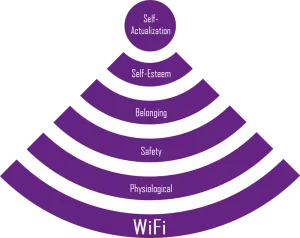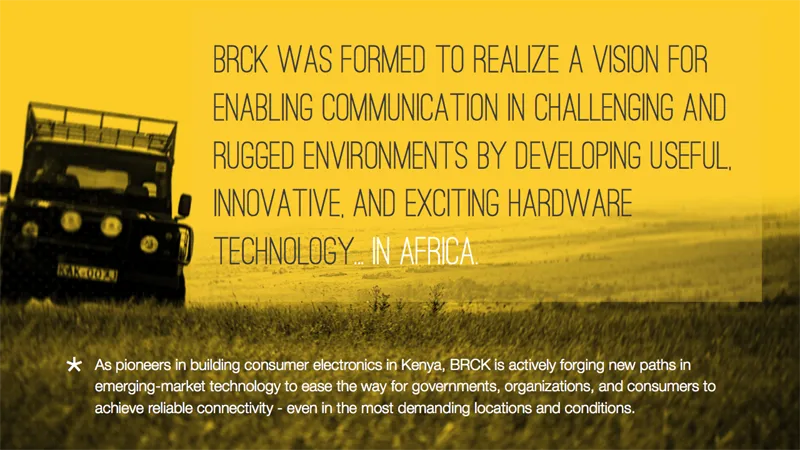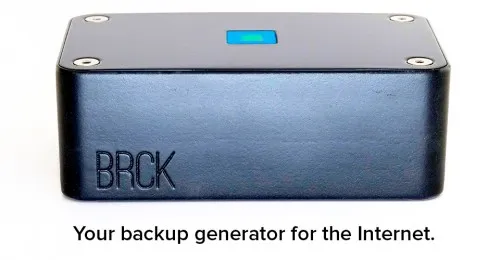The story of BRCK – an African hardware startup ensuring last mile internet connectivity for emerging markets
No kidding! The hierarchy of Maslow has changed; right at the bottom you see wifi as a basic human need.

But the fact of the matter is, across Africa and the developing world Internet connections are far from steady. As our work and web life are being hosted on the cloud more and more every day, we need steady streams of uplink and downlink which most of our ISPs keep failing us on a regular basis.
Brining Internet connectivity to the next 5 billion people is a noble idea, (which many organisations are working on, ex. Google’s ProjectLink Uganda, Loon (drone+balloon), Facebook Internet.org, Microsoft is experimenting with the TV White Spaces spectrum, even South African based). But keeping those who are online consistently connected without interruption is as much a noble mission.
If we have to personify BRCK, it can probably be considered Superman, who can make that happen.
“While all of the big technology companies go after ‘the next big thing’, where they endeavor to stretch the edges of what’s possible with technology, most of the world sits unable to take advantage of the older technology. High-end and brilliant technology is being transplanted from the US and EU to Africa – it is the best technology in the world, it just doesn’t work were we live,” says team BRCK.
What is BRCK?
BRCK is a hardware and cloud services technology platform that delivers rugged and reliable connectivity solutions in the most demanding environments. It is many things for many people, for some it is a router, for some it is modem, for some smart battery. But it is all of that, designed to handle the heat and dust of the developing world. Weighing about 500 grams, the device is 132 mm by 72 mm by 45 mm, similar to the size of a Mac Mini.
What inspired the team behind BRCK
The team exclaims: “As the next 4.5 billion people (65% of the world) start coming online, the need for rugged, reliable, and simple connectivity becomes critical in places with poor infrastructure and limited resources. While existing technologies work well in modern cities, the demands of emerging markets necessitates a rethinking of how technology is engineered, packaged, delivered, and supported. BRCK was conceived in exactly this type of environment. In particular, our struggles in Africa with reliable connectivity inspired us to rethink the entire concept of rugged internet access device - designing the world’s first go-anywhere, connect-to-anything, always available internet device.”
“Why do we use technology designed for London and Los Angeles when we live in Nairobi and New Delhi?” remarks Eric Hersman, the CEO of BRCK.
Those of us who live in Nairobi and New Delhi have different infrastructure needs and have different infrastructural issues. Power goes out, internet connectivity changes. How do you seamlessly change when you are in these old fashioned routers that were developed for different part of the world?

The features of BRCK
It is travel friendly and syncs with any country SIM card. At a time it supports up to 20 wireless connections and has up to 16 gigabytes of storage space so it can work as a back-up server or it can be synced to Dropbox and other connected devices and cloud applications.

Network switching: BRCK comes with built in fail-over in order to switch between wired and wireless internet service providers as per the need. Let me explain this by an example; take your 3G enabled phone network connectivity. In some areas the phone picks up the 3G signal, and in places where 3G is not available, it picks the 2G network. The device switches network-types intelligently, and you don’t have to do a thing. The BRCK also does the same network switching but at a higher level. When one connection goes out, it seamlessly switches between broadband, ethernet cable, Wifi, CDMA and 3G or 4G mobile phone networks. You don’t have to do anything special, just continue your work uninterrupted, as the little smart back box hop between the strongest and best network around you.
Power Backup: As our online life become heavily dependent on services that are hosted on the cloud, access to seamless connection is a must have. But reliable internet is directly related to having reliable power source. Consistent power becomes a distant dream in some places as power goes out without notice. That is why BRCK come with about 8 hours of power back up. It is a device that is created to work in areas where there might be network connectivity, but no power. The icing on the Power Backup cake is, BRCK can be charged via a car battery or plugged to a solar charger. Even without electricity, you've got the best chance possible to staying connected to the web. This makes it suitable for remote field work. You can even charge other things off it, like cellphones and tablets. It is designed to withstand power fluctuation and brownouts.
GPIO slot: It’s made to act as a hub for ‘Internet of Things’ sensors. BRCK comes with programmable GPIO expansion to help you access the Internet of Things. With the port you can connect your BRCK to almost any sensor or computer device. You can also connect it such as with Raspberry Pi cheap computer and make it a mini-server.
BRCK Cloud: It is a platform that you can access from anywhere to check how network connections and electricity are performing on your BRCK. The cloud also contains information about every mobile phone networks in each country. You can also manage alerts and applications remotely from your PC or phone, as well as gather data reported from GPIO attached sensors.
BRCK API makes it easier for developers to write apps for BRCK to extend its usability. BRCK is open for third party hardware integration as well as software add-ons via the API.
Simple setup: A single button to turn it on and off, without a lot of confusing lights.
The Ushahid influence on BRCK
Motto, “if it works in Africa, it will work anywhere.”
Just like they did with location-based crowdsouricng software in 2007, this team is pioneering the consumer web hardware in Africa now. In 2013, BRCK spun out as an independent company though the IP is held by Ushahidi. They’ve structured it in a way that if BRCK does well, so does Ushahidi. Few of you might recall that the Ushahidi crisis-tracker-map has been used in India during that fateful day in Mumbai (26/11). The map has been deployed during blizzards in Washington DC, hurricanes in the US, earthquakes in Japan and Haiti. Usahidi team understands developing world like it’s nobody’s business and they say “BRCK is our answer to a fundamental problem that arises during these situations and during the daily life of much of the world: the need for reliable connections in unpredictable environments."
According to Eric Hersman, “If BRCK takes off Ushahidi won’t need any more funding from anywhere else.”
The need for BRCK & the market reality
“If only 24% in the developing world are connected to the internet, then BRCK targeting 1% of these 3.8 billion unconnected people means a potential market size of $7.7 billion,” says Eric.
Eric exclaims the importance of BRCK and why it is so important for internet growth in Africa and other parts of the world with poor infrastructure. This is why so many focus on building the backbone, and so few focus on the last-mile, the end user.

A few problems faced while building BRCK
A source from Savannah Fund told YourStory Africa, “Raising fund in Africa is a nightmare. We were told ‘Because Eric is a well connected person in the VC circle you might think raising a venture capital would be easy for his world changing idea and product. Wrong!” Eric himself said, “I spend more time teaching investors about Africa.” He added that the perception of Africa is rooted in the stores of the 80s and 90s, but the reality is that the Africa of today is very different. It’s a blue ocean for investors.”
“I know a lot people think it will be easy to get money, you don’t know how hard it is to get money,” highlighted Eric Hersman.
It took the Ushahidi team about 5 months to get the seed fund and obtain approval and licensing for the business. Their successful kickstarter campaign generated a total of USD 172,107
The BRCK team does their prototyping & design work in Nairobi in iHub building, but because of industrial law, and import laws they cannot manufacture there, so they had to do it in Austin, Texas U.S. “As you might expect, this is a very different experience than doing it in China, the US or the EU. While creating physical products is always hard, doing it in Africa is harder. This is due to the difficulties around rapid prototyping, shipping costs and accessibility of components.”

Juliana Rotich, Co-founder of Ushahidi said, "We've shown we can prototype and make, but we still have to pay more than 100 percent duty on components – we have to make a tough business choice."
One of the obvious disadvantages designing hardware in Africa is the lack of prototyping facilities – 3D printed-case in the Silicon Valley takes a few hours – In Africa, it takes few days to be delivered. Hardware is really hard to do. On top of that, the above mentioned limitations make the design process even more stressful.
Finally the time has come: After one-and-a-half years of R&D, today the team is shipping BRCKS for the people who pre-ordered. There are pre-orders in 45 countries across the world. On July 19, they will start shipping worldwide.







